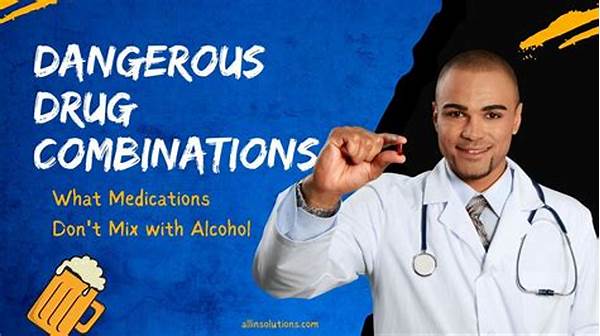The consumption of prescription drugs has become an integral part of healthcare systems worldwide. However, the practice of mixing these medications, either deliberately or inadvertently, poses significant risks. Despite the medical advancements and increased awareness surrounding prescription drugs, misuse and dangerous interactions continue to be prevalent. The consequences of mixing prescription drugs can be severe, manifesting in unexpected side effects, diminished therapeutic efficacy, or even life-threatening scenarios. It is imperative to understand and mitigate these dangers to safeguard patient health and optimize pharmacological benefits.
Read Now : Importance Of Completing A Medicine Course
Understanding Prescription Drug Interactions
Prescription drugs are meticulously formulated to target specific health conditions. However, when multiple medications are consumed simultaneously, they can interact, leading to potentially harmful effects. The dangers of mixing prescription drugs primarily stem from the body’s complex biochemical processes. Drug interactions can result in synergistic effects, where the combined impact is greater than the sum of individual drugs, or antagonistic effects, where one drug diminishes the effect of another. Furthermore, certain combinations can exacerbate side effects, leading to severe health complications. Physicians and pharmacists play a crucial role in evaluating potential drug interactions by considering each patient’s unique medical history, underlying conditions, and prescribed medications to avert the dangers of mixing prescription drugs. The general populace must be adequately informed to consult healthcare professionals before combining medications to avoid adverse health outcomes.
Identifying High-Risk Drug Combinations
1. Anti-Anxiety and Pain Relievers: Combining benzodiazepines with opioids can depress the central nervous system, resulting in lethal respiratory depression, illustrating the dangers of mixing prescription drugs.
2. Antidepressants and Blood Thinners: Concurrent use can increase the risk of bleeding, pointing out the dangers of mixing prescription drugs.
3. Antihistamines and Sedatives: Such combinations enhance sedation, underlining the dangers of mixing prescription drugs.
4. Statins and Antibiotics: This mix may lead to muscle damage or kidney failure, showcasing the dangers of mixing prescription drugs.
5. Diuretics and ACE Inhibitors: Their combination can lead to dangerously low blood pressure, emphasizing the dangers of mixing prescription drugs.
Mitigating the Risks of Drug Interactions
In light of the complexities and potential perils associated with prescription drug interactions, adopting precautionary measures is essential. First and foremost, patients should provide comprehensive medical information, including over-the-counter medications and supplements, to their healthcare providers. This transparency helps physicians and pharmacists assess the potential dangers of mixing prescription drugs. Additionally, healthcare professionals should leverage technological tools, such as drug interaction databases and electronic health records, to identify and manage potential interactions proactively. Patient education initiatives are equally crucial, as well-informed individuals are better equipped to understand dosing instructions and recognize early signs of adverse reactions. Encouraging open dialogue between patients and healthcare providers enables the adoption of safer medication regimens, thereby minimizing the risks associated with the dangers of mixing prescription drugs.
Slang Style Insights
Dude, you’re playing with fire by mixing your meds. Here’s why you should think twice about the dangers of mixing prescription drugs:
1. It’s a total buzzkill if you freak out on unexpected side effects.
2. Your meds won’t work as they should; it’s like wasted effort.
3. Messing with the mix can seriously wreck your health.
4. Overdosing ain’t fun—seriously dangerous stuff here.
Read Now : Herbal Practices In Holistic Health
5. Double trouble if organs can’t handle the mix.
6. Think of your belly – digestion chaos is real.
7. Your doc’s gotta know, or you’re risking a bad time.
8. Brain fog’s a thing; clarity’s outta the window.
9. Might feel like a chemistry set gone wrong.
10. Step back and let your meds do their thing safely.
The Role of Healthcare Providers
Healthcare providers serve as a vital defense mechanism against the dangers of mixing prescription drugs. By conducting detailed patient assessments, they mitigate risks associated with drug interactions. During consultations, physicians and pharmacists can inspect potential medication conflicts, factoring in individual health profiles. They utilize electronic databases to identify harmful combinations, ensuring prescriptions reflect only the safest options for their patients. Moreover, healthcare providers have the responsibility to educate patients, emphasizing the importance of adhering to prescribed drug regimens and warning about possible side effects. Effective communication equips patients with the necessary understanding to follow their treatment plans safely, reducing the dangers of mixing prescription drugs. Pharmacists, with their expertise, also oversee medication dispensing, offering valuable insights into proper dosing and timing, which is crucial to preventing adverse interactions.
Promoting Safe Pharmacological Practices
Ensuring the safe use of prescription drugs involves a collaborative effort between patients and medical practitioners. Regular follow-up appointments allow for the close monitoring of medication effects and timely interventions if adverse reactions emerge. Patients are encouraged to report any discomfort or unusual symptoms associated with their medications. Open discussions during these consultations enhance understanding and trust, facilitating adherence to pharmaceutical guidance. Tools like medication diaries help patients track their drug usage, aiding in identifying any non-obvious interactions. By honoring these practices, the healthcare system actively works to curtail the dangers of mixing prescription drugs. Continuous professional development for healthcare providers is crucial, keeping them updated with the latest research and protocols concerning drug interactions and their associated risks.
Conclusion on Drug Mixing Dangers
In closing, the perils associated with the mixing of prescription drugs cannot be understated. With potential outcomes ranging from subtle side effects to severe health emergencies, vigilance is key. The informed patient, equipped with knowledge and supported by diligent healthcare providers, can navigate the complexities of prescription drug regimens effectively. It is the combined responsibility of the entire healthcare framework to advocate for safer practices, reducing the dangers of mixing prescription drugs. Encouraging diligence, advocating for patient awareness, and maintaining open lines of communication are pivotal in ensuring the well-being of individuals relying on pharmacological solutions for their health needs. By fostering a culture of safety and education, the medical community can make significant strides in minimizing adverse drug interactions and promoting overall public health.
